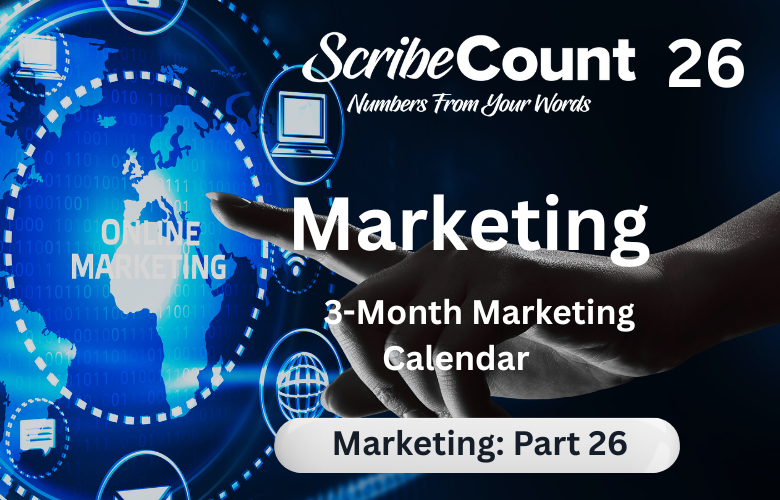3-Month Marketing Calendar for Indie Authors: Launching Your Book with Purpose
Marketing a new book isn’t about throwing ideas at the wall and hoping something sticks — it’s about coordination. With dozens of platforms, tactics, and tools available to indie authors, a structured calendar helps transform overwhelm into action. Below is a fully developed three-month calendar designed to help you build momentum, engage readers, and maximize sales around your next book launch.
We’ll walk through what to do, when to do it, why it matters, and what tools can help you automate parts of the process. This calendar is tailored for fiction authors launching a new title, with flexibility for various genres and platforms.
Month 1: Preparation and Warm-Up (Weeks -12 to -8)
Your launch doesn't begin when the book goes live. It begins long before, when you start seeding interest. This is your pre-launch window — when planning, reader engagement, and platform prep begins.
Week -12: Announce and Align
- Finalize launch date.
- Set up your marketing calendar in tools like ScribeCount or Notion. ScribeCount also lets you align marketing efforts with actual sales data.
- Announce the book to your email list and social media followers.
- Update bios and social media headers to tease the upcoming release.
Expected Outcome: Generate initial awareness and create a sense of anticipation.
Week -11: ARC Team and Influencer Outreach
- Recruit ARC readers via email, BookFunnel, or StoryOrigin.
- Reach out to book bloggers, Bookstagrammers, and BookTokers.
- Upload your book to Goodreads, and set up a Giveaway if applicable.
Expected Outcome: Secure early reviews and start building community buzz.
Week -10: Backlist Audit and Funnel Prep
- Ensure all backlist books have links to your upcoming title in the back matter.
- Set up or revise automated email flows to point toward the new book.
- Add a landing page for the new release (via Booklinker, Books2Read, or your own website).
- Start drafting launch week emails.
Expected Outcome: Get your ecosystem aligned to point traffic toward your new release.
Month 2: Hype and Soft Promotions (Weeks -8 to -4)
This month is all about escalating awareness and warming up readers and algorithms.
Week -8: Cover Reveal and Social Engagement
- Share your cover reveal on social platforms and your website.
- Create teaser graphics using Canva or BookBrush.
- Schedule posts using Later, Buffer, or Planoly.
- Launch a preorder campaign (if you’re offering preorders).
Expected Outcome: Drive traffic to your book’s page and improve discoverability.
Week -7: Email Engagement
- Send a behind-the-scenes email or character profile to your list.
- Begin a countdown series in your email marketing system.
- Use email providers like Klaviyo, MailerLite, or ConvertKit to automate these campaigns.
Expected Outcome: Maintain email list warmth and generate early clicks.
Week -6: Partner Content and Guest Spots
- Submit guest blog posts to popular sites in your niche.
- Appear on book-related podcasts or author livestreams.
- Schedule interviews and cross-promotions with other authors.
Expected Outcome: Expand reach and get in front of new readers via borrowed audiences.
Week -5: Run a Price Promotion
- Drop the price of a backlist book to free or $0.99.
- Promote it via Written Word Media, BookBub, Freebooksy, and others.
- Schedule ad support via Facebook or Amazon Ads.
Expected Outcome: Pull readers into your universe and upsell them to the new release.
Month 3: Launch and Afterburn (Weeks -4 to +4)
The big moment is here — but this is no time to coast. A strong launch requires focus, energy, and the right combination of organic, automated, and paid marketing.
Week -4: Final Countdown
- Post daily countdown updates on Instagram Reels and TikTok using Later or Metricool.
- Share exclusive snippets on Facebook, targeting fans and groups.
- Launch a retargeting ad campaign for visitors to your site or sales page.
Expected Outcome: Create last-minute urgency and engagement.
Week -3: Finalize Your Launch Stack
- Set up launch week promos using promo stacking: combine email newsletters, paid ads, ARC pushes, and direct links.
- Confirm Amazon categories and metadata.
Expected Outcome: Ensure all elements are in place for a synchronized launch.
Week -2: Launch Week
- Send your launch day email.
- Activate BookBub Featured Deal (if accepted).
- Go live with author livestream on Facebook, YouTube, or TikTok.
- Share screenshots of rankings and reviews on social.
Expected Outcome: Maximize first-week visibility and capture early reviews.
Week +1: The Afterburn
- Re-share top reviews on social media.
- Send a thank-you email and remind readers to review.
- Update the automated welcome series to mention the new book.
- Run Facebook lookalike audiences to retarget engaged readers.
Expected Outcome: Turn launch readers into long-term fans and maximize the algorithm boost.
Tools That Help Automate and Track Your Plan
ScribeCount (Link)
A sales and marketing analytics tool that aligns data from Amazon, Kobo, Apple Books, and others. The calendar feature allows authors to log marketing activity and match it against real-time sales.
Later (Link)
Ideal for scheduling Instagram Reels, TikToks, and Facebook posts in advance. Visual drag-and-drop calendar makes campaign planning easy.
Buffer (Link)
A straightforward scheduling tool that integrates with most major platforms and offers solid analytics for performance tracking.
Planoly (Link)
Popular for Instagram and Pinterest, with grid planning and caption scheduling. Great for authors who lean heavily on visual marketing.
Zapier (Link)
Not a scheduler, but a workflow automation tool. Connects services like MailerLite + Google Sheets + ScribeCount to trigger actions when certain events happen.
Why This Calendar Works
A well-structured marketing calendar turns indie authors into effective business owners. You’re no longer guessing at what to do — you’re working within a timeline that respects your energy, builds your audience slowly, and promotes consistently.
Authors who follow this kind of structured plan see:
- Higher preorders and early sales
- Better launch-week rankings
- Improved ROI on ads
- More consistent social media engagement
- Less burnout and more writing time
You can repeat this cycle every time you launch — just tweak the content and promotional tools based on what worked. Better still, log every step and result in your calendar (preferably a tool like ScribeCount) so future launches grow stronger.

